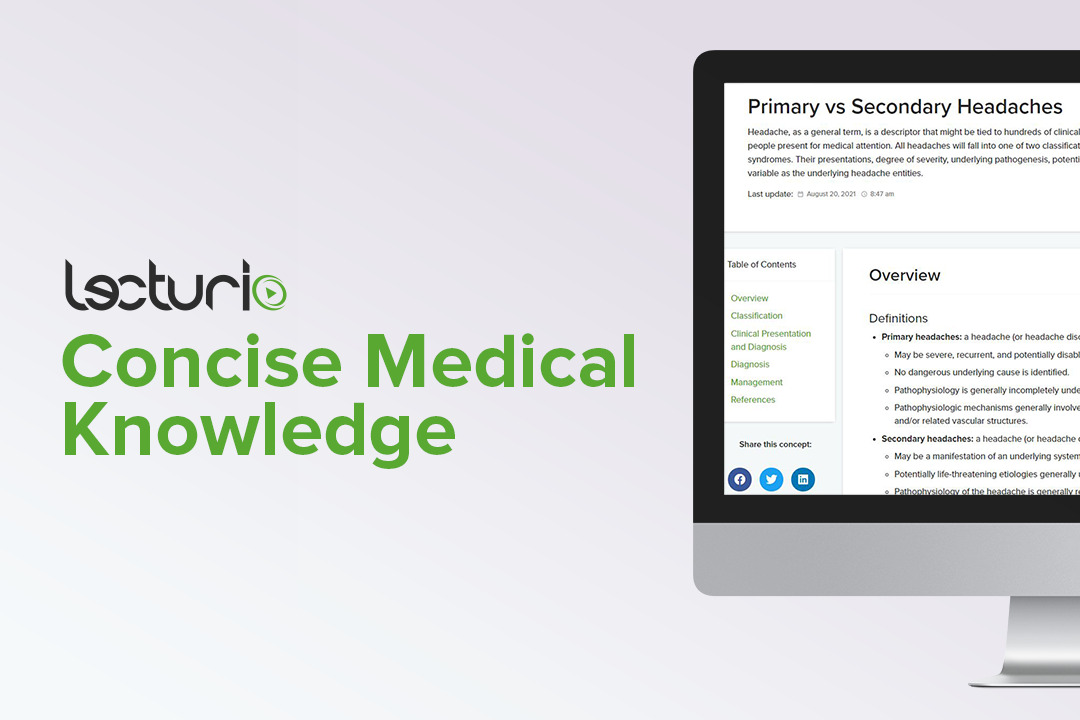Playlist
Show Playlist
Hide Playlist
Trigeminal Autonomic Cephalalgias (TACs)
-
Slides Headaches Paroxysmal Episodic Headaches.pdf
-
Download Lecture Overview
00:01 So let's talk about the TACs, the trigeminal autonomic cephalalgias, they're less common. 00:07 We don't see them as much as migraine and tension-type. 00:10 But when we see them, you got to be able to diagnose this condition. 00:13 It's managed very differently from migraine and in tension-type. 00:17 And for patients, it can really be quite a severe cause of head pain and require urgent intervention to help alleviate their suffering. 00:26 How do patients describe headaches from a trigeminal autonomic cephalalgia? Typically, these are short lasting headaches with prominent autonomic features, often on the same side as a unilateral headache. 00:40 The various syndromes and we'll talk about 3 or 4 TAC syndromes differ in the attack frequency and duration. 00:47 There's some overlap with trigeminal neuralgia and we'll talk about the pathophysiology of these and learn about that. 00:53 There's activation of the trigeminal autonomic reflex. 00:56 And this is what causes those autonomic findings tearing or rhinorrhea or miosis or mydriasis and prominent autonomic findings as a result of parasympathetic overactivity and sympathetic underactivity. 01:10 And there's some evidence also for hypothalamic activation, which may contribute to patient symptoms. 01:15 Interestingly, patient's symptoms are often in a trigeminal distribution, typically in a V1 distribution. 01:21 Though sometimes we do see V2, V3 distribution, like trigeminal neuralgia. 01:27 What's the pathophysiology of the trigeminal autonomic cephalalgias? How do these work? What causes them? Well, there's a number of systems that are activated that contribute to pain in these patients. 01:39 And the first is activation of the pain system. 01:42 The trigeminal nerve and the trigeminal vascular complex. 01:46 This exists in the medulla down in the medullary region of the brainstem and extends up into the trigeminal nerve and nuclear regions. 01:55 This connects to the pain neuromatrix which is thought to generate pain and contribute to pain. 02:02 The molecule that is involved in activation of the trigeminal vascular complex is thought to be CGRP. 02:08 This is a prominent molecule involved in the pathophysiology. 02:12 And this has been a target for some of the triptans and other agents. 02:16 In general, this pain system is called the pain neuromatrix system and this contributes to pain in these patients who present with TACs. 02:23 In addition, we see cranial autonomic system activation through activation at the level of the superior salivary nucleus that connects to the sphenopalatine ganglion. 02:34 And the molecule that's critical in this pathway is the VIP, protein vasoactive intestinal peptide, and this has been a target for oxygen that can be delivered as an abortive agent for patients with cluster. 02:49 In addition to the sphenopalatine ganglion has been implicated in the activation of the system and sometimes we consider blocks into the sphenopalatine ganglion anaesthetic blocks to manage patients who have particularly difficult to treat pain. 03:03 And then the last is the hypothalamic system. 03:05 And activation of the hypothalamic system is also thought to contribute to some of the autonomic features that we see in the TACs. 03:11 Important molecules here is melatonin. 03:13 And this has been a target for Verapamil and lithium, and may explain why patients have prominent autonomic features which we don't see with migraine and tension-type. 03:23 So how do we approach these patients with a trigeminal autonomic cephalalgia? How do we make a diagnosis? How do we know what type of TAC it is? Well, this algorithm helps. 03:34 All patients present with chronic recurrent episodes. 03:36 So episodes where they have very severe headache attacks that often remit and they have a headache free interval followed by a clustering of attacks. 03:44 Patients have prominent autonomic features. 03:46 So we ask about tearing and rhinorrhea and miosis and mydriasis, change in the size of the pupil. 03:54 And most importantly, we want to quantify the duration of the attacks. 03:58 Attacks may last 15 to 180 minutes, attacks may last 2 to 30 minutes, or attacks may be very short, lasting 1 to 10 minutes. 04:10 Those that last a little bit longer, we tend to categorize as cluster. 04:13 Cluster headache tends to last 15 to 180 minutes. 04:17 The TAC that tends to last this intermediate duration, 2 to 30 minutes is the paroxysmal hemicrania. 04:23 And those very short attacks tend to be seen in patients with SUNCT. 04:28 Short-lasting unilateral, headache or neuralgia form headache with conjunctival, injection and tearing. 04:33 And so this is how we categorize the type of TAC that a patient may be presenting with.
About the Lecture
The lecture Trigeminal Autonomic Cephalalgias (TACs) by Roy Strowd, MD is from the course Headache.
Included Quiz Questions
What molecule is involved in the activation of the trigeminovascular complex?
- Calcitonin gene-related peptide (CGRP)
- Vasoactive intestinal peptide (VIP)
- Melatonin
- Interleukin-1
- Tumor necrosis factor-alpha
What molecule is involved in the activation of the hypothalamic system involved in pain?
- Melatonin
- Substance P
- Vasoactive intestinal peptide (VIP)
- Calcitonin gene-related peptide (CGRP)
- Angiotensin
Customer reviews
5,0 of 5 stars
| 5 Stars |
|
1 |
| 4 Stars |
|
0 |
| 3 Stars |
|
0 |
| 2 Stars |
|
0 |
| 1 Star |
|
0 |
very difficult topic explained in easy laid out way. Makes the topic very digestable.




